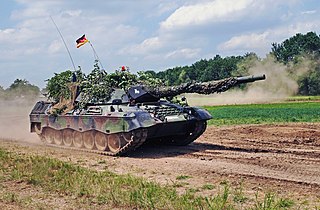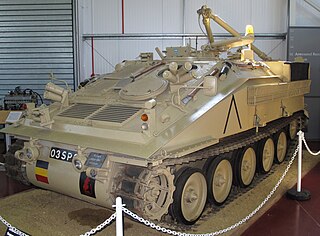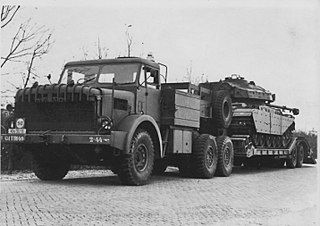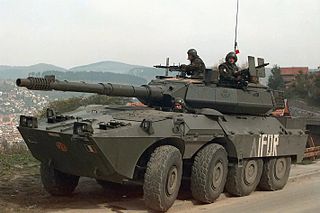
A military engineering vehicle is a vehicle built for construction work or for the transportation of combat engineers on the battlefield. These vehicles may be modified civilian equipment or purpose-built military vehicles. The first appearance of such vehicles coincided with the appearance of the first tanks, these vehicles were modified Mark V tanks for bridging and mine clearance. Modern military engineering vehicles are expected to fulfill numerous roles such as; bulldozer, crane, grader, excavator, dump truck, breaching vehicle, bridging vehicle, military ferry, amphibious crossing vehicle, and combat engineer section carrier.

The FV4034 Challenger 2 is a third generation British main battle tank (MBT) in service with the armies of the United Kingdom, Oman, and Ukraine.

The Kampfpanzer Leopard is a main battle tank designed by Porsche and manufactured by Krauss-Maffei in West Germany, first entering service in 1965. Developed in an era when HEAT warheads were thought to make conventional heavy armour of limited value, the Leopard design focused on effective firepower and mobility instead of heavy protection. It featured moderate armour, only effective against low caliber autocannons and heavy machine guns, giving it a high power-to-weight ratio. This, coupled with a modern suspension and drivetrain, gave the Leopard superior mobility and cross-country performance compared to most other main battle tanks of the era, only being rivaled by the French AMX-30 and Swedish Strv 103. The main armament of the Leopard consisted of a German license-built version of the British Royal Ordnance L7 105 mm rifled gun, one of the most effective and widespread tank guns of the era.

The Leopard 2 is a third generation German main battle tank (MBT). Developed by Krauss-Maffei in the 1970s, the tank entered service in 1979 and replaced the earlier Leopard 1 as the main battle tank of the West German army. Various iterations of the Leopard 2 continue to be operated by the armed forces of Germany, as well as 13 other European countries, and several non-European countries, including Canada, Chile, Indonesia, and Singapore. Some operating countries have licensed the Leopard 2 design for local production and domestic development.

The Boxer is a multirole armoured fighting vehicle designed by an international consortium to accomplish a number of operations through the use of installable mission modules. The governments participating in the Boxer programme have changed as the programme has developed. The Boxer vehicle is produced by the ARTEC GmbH industrial group, and the programme is being managed by OCCAR. ARTEC GmbH is based in Munich; its parent companies are KNDS Deutschland GmbH & Co and Rheinmetall Land Systeme GmbH on the German side, and Rheinmetall Defence Nederland B.V. for the Netherlands. Overall, Rheinmetall has a 64% stake in the joint venture.

FV106 Samson was a British Army armoured recovery vehicle, one of the CVR(T) family. The main role of this vehicle was to recover the CVR(T) family of vehicles, but could also recover other light tracked vehicles such as the FV430 series.

The FV4030/4 Challenger 1 is a British main battle tank (MBT) used by the British Army from 1983 to 2001, when it was superseded by the Challenger 2. The majority of the Challenger 1 fleet was subsequently sold to Jordan where it remained in service with the Royal Jordanian Army until withdrawals were announced in 2018. Known locally as Al-Hussein, these vehicles received various Jordanian modifications before being replaced by French-made Leclerc tanks from the UAE and ex-Italian B1 Centauro 8x8 wheeled tank destroyers. The Jordanian Challenger 1 fleet had been retired by January 2023.

The FV510 Warrior tracked vehicle family is a series of British armoured vehicles, originally developed to replace FV430 series armoured vehicles. The Warrior started life as the MCV-80, "Mechanised Combat Vehicle for the 1980s". One of the requirements of the new vehicle was a top speed able to keep up with the projected new MBT, the MBT-80 – later cancelled and replaced by what became the Challenger 1 – which the FV432 armoured personnel carrier could not. The project was begun in 1972; GKN Defence won the production contract in 1984 and the Warrior was accepted for service with the British Army in November 1984. Production commenced in January 1986 at Telford, with the first vehicles completed in December that year. GKN Defence was purchased by BAE Systems, via Alvis plc.

The FV 214 Conqueror, also known as tank, heavy No. 1, 120 mm gun, Conqueror was a British heavy tank of the post-World War II era. It was developed as a response to the Soviet IS-3 heavy tank. The Conqueror's main armament, an L1 120 mm gun, was larger than the 20-pounder (83.4 mm) gun carried by its peer, the Centurion. The Conqueror's role was to provide long range anti-tank support for the Centurion. Nine Conquerors were issued for each regiment in Germany, usually grouped in three tank troops. In the British Army both the Conqueror and the Centurion were replaced by the Chieftain.

The Mighty Antar was a heavy-duty 6×4 tractor unit built by Thornycroft from the late 1940s onwards. For some decades it was the standard tank transporter of the British Army and was also used by other nations. It was powered by a shortened V8 land version of the V12 Meteor engine, derived from the Merlin and modified to run on diesel, known as the Rolls-Royce Meteorite.

An armoured recovery vehicle (ARV) is typically a powerful tank or armoured personnel carrier (APC) chassis modified for use during combat for military vehicle recovery (towing) or repair of battle-damaged, stuck, and/or inoperable armoured fighting vehicles, such as tanks and armoured personnel carriers. Most ARVs have motorized tracks, like a tank or bulldozer, enabling the ARV to operate on uneven ground. The term "armoured repair and recovery vehicle" (ARRV) is also used.

The TPz Fuchs from Transportpanzer Fuchs is a German armoured personnel carrier originally developed by Daimler-Benz, and manufactured and further developed by Rheinmetall MAN Military Vehicles (RMMV). Fuchs was the second wheeled armoured vehicle to enter service with the Bundeswehr. It can be used for tasks including troop transport, engineer transport, bomb disposal, nuclear, biological and chemical reconnaissance and electronic warfare. RMMV and its predecessors manufactured 1,236 Fuchs 1, mostly for the German Army.

The Centauro is a family of Italian military vehicles originating from a wheeled tank destroyer for light to medium territorial defense and tactical reconnaissance. It was developed by a consortium of manufacturers, the Società Consortile Iveco Fiat - OTO Melara (CIO). Iveco Fiat was tasked with developing the hull and propulsion systems while Oto Melara was responsible for developing the turrets and weapon systems.

The M88 recovery vehicle is one of the largest armored recovery vehicles (ARV) in use by United States Armed Forces. There are three variants, the M88, the M88A1, and the M88A2 HERCULES. The M88 series has seen action in the Vietnam War, the Persian Gulf War, the Iraq War, and the War in Afghanistan, and to a lesser extent during the Kosovo War, where they were deployed to help recover heavy armored vehicles of the Allied ground units. As of 2000, the M88A2 replacement cost was around US$2,050,000.

The REME Museum is within the MoD Lyneham site, in Lyneham, Wiltshire, England, about 9 miles (14 km) southwest of Swindon. The museum holds collections of technological and historical artefacts associated with the work of the Royal Electrical and Mechanical Engineers (REME), the corps of the British Army responsible for the maintenance, servicing and inspection of electrical and mechanical equipment.

A tank transporter is a combination of a heavy tractor unit or a ballast tractor and a mating full trailer, hydraulic modular trailer or semi-trailer, used for transporting tanks and other armoured fighting vehicles. Some also function as tank recovery vehicles, the tractors of which may be armoured for protection in combat conditions.

The FV434 is the Armoured Repair Vehicle variant of the British Army's FV430 series of armoured fighting vehicles. Introduced in the 1960s primarily as a means of quickly changing Chieftain MBT power packs in the field, it is operated by the Royal Electrical and Mechanical Engineers (REME). It is still used by the REME.

The HX family are a range of purpose-designed tactical military trucks manufactured by Rheinmetall MAN Military Vehicles (RMMV). The HX range was disclosed in 2003, and the first order was placed in 2004. The HX range replaced the earlier FX and LX ranges in production.

The Lynx is a German armoured fighting vehicle developed by Rheinmetall Landsysteme. The Lynx, configured as a KF31 infantry fighting vehicle (IFV), was unveiled at the Eurosatory defence exhibition on 14 June 2016. The KF41 variant was unveiled at the Eurosatory defence exhibition on 12 June 2018.

Challenger 3 (CR3) is a British fourth-generation main battle tank in development for the British Army. It will be produced by the conversion of existing Challenger 2 tanks by the British/German Rheinmetall BAE Systems Land joint venture.























